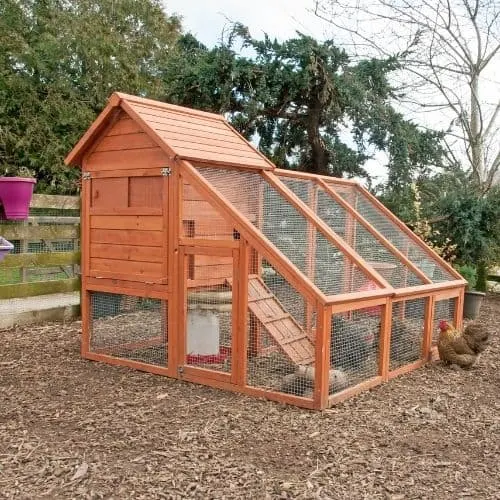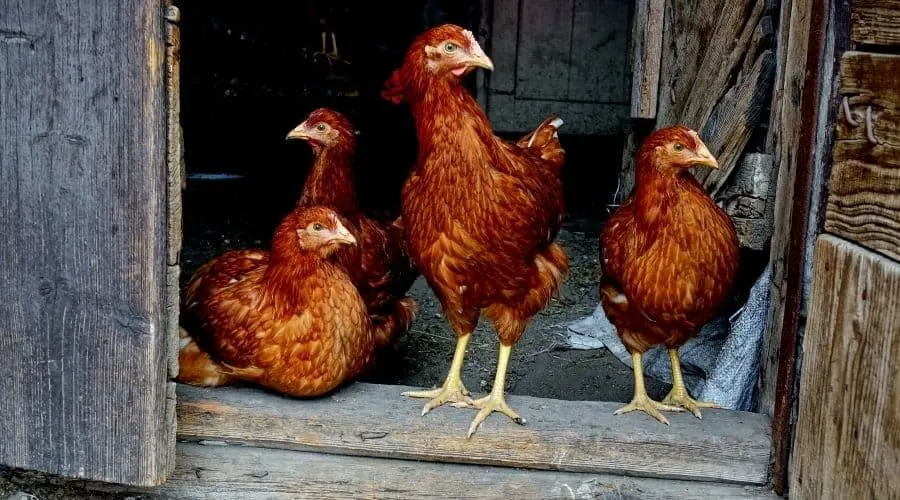Chickens love spending time outdoors scratching and grazing for natural foods, but if you live in an area where rain is a common occurrence it can be a worry for chicken owners when they’re spending all day in the wet.
Living in North Wales (which is one of the rainiest parts of the UK), our chickens definitely get to experience the elements first hand, but is it ok for chickens to be let out when it’s raining?
Allowing chickens to be out in light rain is generally safe, as they can enjoy foraging and often seek shelter instinctively when needed. However, during heavy rains or cold weather, it’s advisable to provide them with a dry, sheltered area to prevent health issues like hypothermia or respiratory problems.
Chickens are capable of deciding when to seek cover, but caretakers should always ensure they have access to a safe, dry space.
Read on to find out more about letting chickens out in the rain and how to make sure they have enough shelter from the elements.
Do chickens like rain?
Some chickens don’t like the rain and will seek shelter, where others will happily carry on grazing as if nothing is happening.
If the rain is light this shouldn’t bother them too much and in fact, rain can provide benefits because the wet ground will encourage treats such worms and slugs to come to the surface.
Heavy wind and rain has the potential to make chickens more uncomfortable but some will still happily graze because for chickens their joy of grazing outweighs getting a bit wet!
Pentagon Pet is the owner of this article that was first published on October 29, 2020.
We have free-range hybrid hens who are pretty hardy and will happily graze in all weathers, whereas our small Leghorn will choose to sit inside the coop and ride out any wind and rain.
Making chicken coops and runs more weatherproof
Although chickens will happily wander around in the rain it’s important to give them the option of shelter along with ensuring the coop is rainproof and dry inside.
A good way to provide shelter is by having a cover over part of the run so they can still spend time outside while keeping dry.
Some raised coops also offer shelter underneath the coop, so if you’re looking to start out and you live in rainy area then this is a good option for you (see example in the image below).

It’s important to check for leaks inside the coop because this will quickly cause the coop to become damp on the inside along with mould which can become harmful for chickens.
After a long damp day chickens will need somewhere cosy and dry to roost in the evening.
Providing chickens with shelter during bad weather
Chickens will shelter under trees and hedges or anywhere they can find, in many cases, you can spend time and money building the perfect shelter and they’ll just go and find their own instead.
Here are some ideas on how to create a chicken shelter without spending money:
- Give them access to a greenhouse or polytunnel during the winter months – making sure the door is left open for ventilation and so they can come and go.
- If you have an unused shed or outhouse this can create a perfect shelter for chickens.
- In winter place an outdoor table in a sheltered corner for the chickens to sit under.
You can also buy purpose made chicken shelters and large predator proof covered runs from Omlet.

Having a good ground covering in the run is also important during the wetter months, the following post gives more info on this topic:
Do chickens need grass in their run?
Can you keep chickens inside if the weather is bad?
Ideally, a chicken should always be given the option to spend time outside during the day, whether this is during free-range time or within a chicken run.
Chickens don’t like to be kept inside a coop for long periods of time and this can lead to them becoming bored and may promote bad behaviour such as pecking and egg eating.
In most situations, It’s better to allow the chickens to go outside while providing and giving the chickens the option to seek their own shelter if need be.
Our chickens hate being inside outside of roosting time and would much rather be a bit soggy than trapped inside. Even if we keep them in the run they start complaining, they just love being outside.
There are a few exceptions to this rule, which I’ll cover in the next section.
When shouldn’t you let chickens out in the rain?
In most situations, it’s fine to let your chickens out in the rain, but there are some exceptions to this rule, these include:
- Young chicks and birds – chicks and birds with underdeveloped feathers aren’t yet hardy and ready for bad weather and should be kept inside.
- If a chicken is ill – going out in the rain is not a good idea in this situation and ideally they should be kept inside and in a warm place.
- Chickens who have lost most of their feathers – ex-battery hens or hens going through an extreme moult are best kept in a covered run with the option to go inside the coop when they need to.
- Small breed and less hardy breeds – some chicken breeds come from hot countries and don’t deal well with getting cold and wet.
In most situations, it’s best to use a common-sense approach, when letting your chickens out in bad weather. If for some reason your hens can’t go in the rain it is better to cover over the top of the run rather than keeping them locked in the coop.
Related topics
I hope this article has helped you find out more about letting chickens out in the rain, you might also find the following post helpful with tips and ideas on how to protect your chickens from the elements:
Keeping chickens warm in winter and during cold weather
Do chickens need grass in their run?
Will chickens run away if you let them loose to free-range?
Can you keep chickens in the coop or run all day?
Do chickens need a run around their coop?
Our recommended coop
Chicken coop for different flock sizes and different weather.
This article and its contents are owned by Pentagon Pets and was first published on October 29, 2020.

